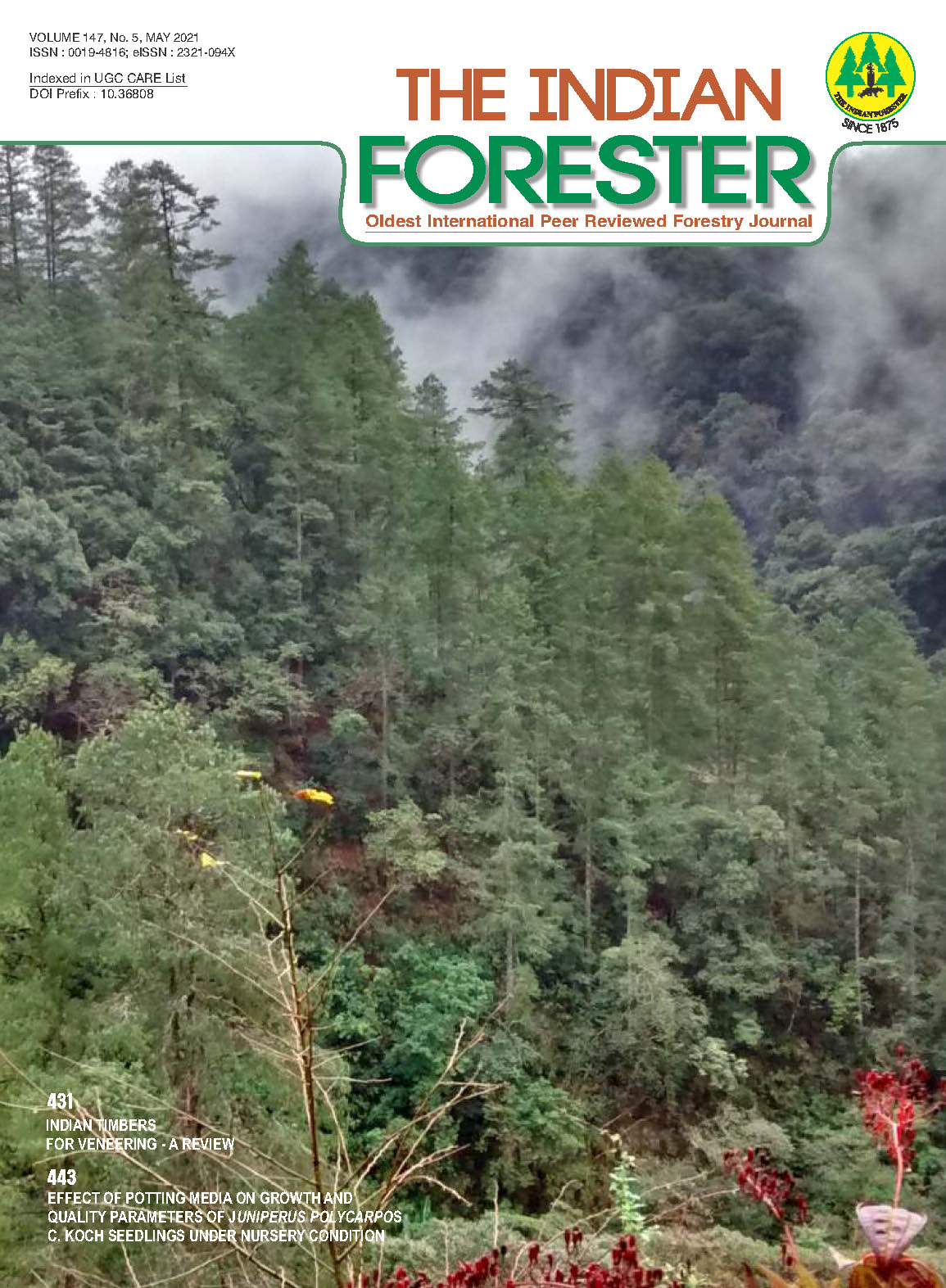Hitherto Unrecorded Hydrophytes of Nal Sarovar Bird Sanctuary (A Ramsar Site)
DOI:
https://doi.org/10.36808/if/2021/v147i5/155539Keywords:
Hydrophytes, Nal Sarovar, Ramsar site, Wetland.Abstract
Nal Sarovar Sanctuary and the Ramsar Site in Gujarat is known for its diversity and abundance of migratory and resident-migratory waterbirds. Though it is also rich in hydrophytic and halophytic vegetation, relatively limited research work has been done on them till date. Seasonal monitoring of this wetland was carried out from 2016 to 2019 with habitat based stratified random sampling approach. During the study, a total of 19 hydrophyte species were recorded in 2019 of which 4 hydrophytes were never reported earlier from this wetland-based sanctuary. The four hydrophytes were Ceratophyllum demersum (a free-floating submerged hydrophyte), Utricularia stellaris (rooted submerged hydrophyte), Ottelia alismoides (a rooted submerged hydrophyte) and Limnophyton obtusifolum (an emergent hydrophyte). They were recorded in shallow water marshy habitats of the Nal Sarovar Sanctuary and Ramsar Site. They were found in association with other hydrophytes like Chara sp., Ipomoea aquatica and Nymphaea nouchali. Per cent cover value (determined using Daubenmire frame) for Ceratophyllum demersum and Utricularia stellaris was 1% each. On the other hand, Ottellia alismoides and Limnophyton obtusifolum were found to have 4% and 2% canopy coverage respectively at the site where they were recorded. They were recorded at a depth of about 80-100 cm and having turbidity in the range of 0.1 to 0.6 NTU and salinity ranging from 0.8 to 2 ppt.References
APG. (2016). An update of the angiosperm phylogeny group classification for the orders and families of flowering plants: APG IV. Botanical Journal of Linnean Society, 181: 1-20.
Cook C.D.K. (1996). Aquatic and wetland plants of India.Oxford University Press, London. 385p
Fischer E., Barthlott W., Seine R. and Theisen I. (2004). Lentibulariaceae. In:Kubitzki, K. (Eds). The Families and Genera of Vascular Plants. Berlin, Heidelberg, New York, Springer. 276-282 pp.
Gaudet C.L. and Keddy P.A. (1995). Competitive performance and species distribution in shoreline plant communities: A comparative approach. Ecology, 76: 280-291.
GEER. (1998). Environmental impact assessment of SardarSarovar project on NalSarovar Bird Sanctuary. Gujarat Ecological Education and Research Foundation (GEER), Gandhinagar.138 pp.
GEER. (2018). Ecological Monitoring of Nal Sarovar WetlandA Sanctuary and the Ramsar Site of Gujarat (2016-2018). Gujarat Ecological Education and Research Foundation (GEER), Gandhinagar.313 pp.
Gujar, R.V., Tatu, K. and Kamboj, R.D. (2018). A study on the hydrophytes and halophytes of Nal Sarovar and Chhari Dhand Wetlands of Gujarat, India. Research and Review: Journal of Ecology, 7(1): 33-40.
Isacch J.P., Costa C.S.B., RodrÃguez-Gallego L., Conde D., Escapa M., Gagliardini D.A. and Iribarne O.O. (2006). Distribution of saltmarsh plant communities associated with environmental factors along a latitudinal gradient on the south-west Atlantic coast. Journal of Biogeography, 3: 888900.
Janarthanam M.K. and Henry A.N. (1992). Bladderworts of India, Botanical Survey of India, Calcutta. 144 pp.
Kamboj R.D., Tatu K. and Gujar R.V. (2019). A Field Guide for Identification of Common Wetland Plants (with emphasis on hydrophytes). Gujarat Ecological Education & Research (GEER) Foundation, Gandhinagar.
Les D.H. (1986). Systematics and evolution of Ceratophyllum L. (Ceratophyllaceae). A monograph [Ph.D. dissertation]. The Ohio State University, Columbus.1986.
Li Z.Z., Wu S., Zou C.Y., Liu Y., Hu G.W., Lehtonen S.Wang, Q.F. and Chen J.M. (2019). Otteliafengshanensis, a new bisexual species of Ottelia (Hydrocharitaceae) from southwestern China. PhytoKeys, 135: 1-10.
Niering W.A. (1986). Wetland. The Audubon Society. Alfred A. Knopf, New York. 538 p.
Sasikumar K. (2014). Management plan for Nal Sarovar Bird Sanctuary, Gujarat Forest Department. 280 pp.
Shah G.L. (1978). Flora of Gujarat state Vol. I & II. Vallabh Vidhyanagar: Sardar Patel University Press.
Parikh P., Unadkat K. and Nagar P. (2015). Study of aquatic weeds in two ponds of Vadodara, Gujarat. International Journal of Allied Practice, Research and Review, 2(1): 1-7.
Rana K.G. and Nagar P. S. (2017). Diversity and distribution of endemic Angiosperms in Gujarat. International Journal of Advanced Research, 5(6): 730-758.
Space Applications Centre (SAC). (2011). National Wetland Atlas. SAC-ISRO, Ahmedabad.
Subramanyam K. (1962). Aquatic angiosperms (Botanical monograph no 3). CSIR, New Delhi. 190 pp.
Welch B.A., Davis C.B. and Gates R.J. (2006). Dominant environmental factors in wetland plant communities invaded by Phragmitesaustralis in East Harbor, Ohio, USA. Wetland Ecology and Management, 14: 511-525.
Yadav S.R., Sardesai M.M. and Gaikwad P. (2005). A new species of Utricularia (Lentibulariaceae) from Western Ghats of Maharashtra, India. Rheedea, 15(1): 71-73.
Yadav S.R., Sardesai M.M. and Gaikwad S.P. (2002). Two new species of UtriculariaL. (Lentibulariaceae) from Peninsular India. Rheedea. 10(2): 107-112.
Zheng X., Fu J., Ramamonjisoa N., Zhu W., He C. and Lu C. (2006). Relationship between wetland plant communities and environmental factors in the Tumen river basin in northeast China. Sustainability, 11(6): 1559.
Downloads
Downloads
Published
How to Cite
Issue
Section
License
Unless otherwise stated, copyright or similar rights in all materials presented on the site, including graphical images, are owned by Indian Forester.





